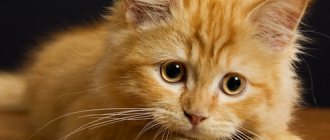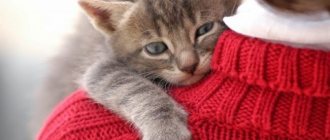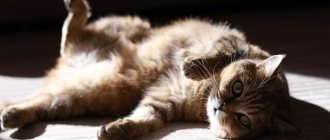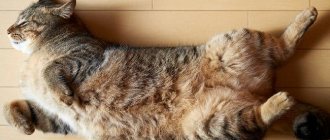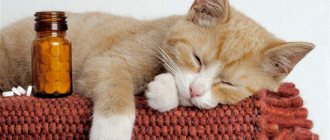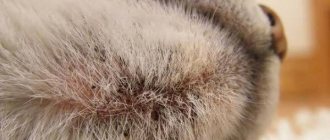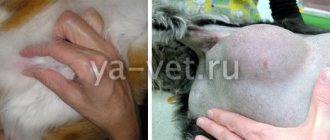Diseases that cause a cat's nose to peel off are varied: fungal infection, skin parasites, allergic reaction, skin injury. The condition may be accompanied by itching, the appearance of scales and crusts, and hair loss around the nasal mucosa. At the first symptoms, your pet should be shown to a veterinarian, who will prescribe therapy based on the examination results.
According to veterinarians, flaking of the nose or the appearance of discharge may signal dangerous feline infections - rhinotracheitis or calcivirosis.
Why does a cat go bald: reasons
Baldness (alopecia) leads to the appearance of bare patches of skin on your pet's body.
If there is too much hair, bald spots appear, the animal behaves restlessly
The main reasons for the development of pathology:
- allergic reaction;
- damage by fleas, lice;
- the presence of a scabies parasite;
- otodectosis (ear mites);
- fungal or lichen infections (dermatomycosis, dermatophytosis);
- pyoderma;
- purulent formations on the skin;
- oily seborrhea;
- deficiency or excess of thyroid hormones;
- increased work of the adrenal glands;
- diabetes;
- genetic predisposition;
- stress;
- lack of vitamins;
- chronic diseases of internal organs.
Important! A common cause of alopecia is food allergies. It is not recommended to give pets food from the human table. Veterinarians advise buying specialized food that contains the necessary vitamins and minerals.
Why does pathology occur?
Fungal infection
Mycoses around the nose are provoked by trichophyton, microsporum or Candida yeast. It manifests itself mainly due to a decrease in local or general immunity. This is facilitated by frequent bathing of the pet, abuse of hygiene products, and frequent colds. Cats can also become infected from sick animals. Symptoms:
- itching;
- hair loss around the nose or throughout the body;
- formation of scales or crusts;
- skin redness;
- formation of cracks;
- general deterioration of condition.
Return to contents
Skin parasites
Often the cause of dermatitis on the face is fleas, lice eaters, notoedrosis or ear mites, the waste products of which irritate the skin around the nose. Infection occurs through contact with infected animals. The first symptoms appear on the body - the neck, behind the ears in the form of bald spots and severe itching. Then the disease spreads to the muzzle and manifests itself as follows:
- the appearance of erosions or ulcers near the nasal mirror;
- redness of the skin;
- hair loss;
- formation of a black stripe along the edge of the nose.
Return to contents
Allergic reaction
The skin on a cat's nose is one of the most sensitive places on the animal's body. Therefore, it quickly reacts to allergenic agents. These include:
- food and vitamin supplements;
- components of veterinary preparations;
- dust;
- household chemicals;
- plant pollen;
- fresh fish and some seafood;
- chicken eggs;
- dairy products;
- pork meat.
A sign of an allergen affecting your pet’s body may be the appearance of discharge from the organs of vision.
A kitten's nose may peel off due to stuck food particles that irritate the skin, since the baby does not yet know how to fully wash himself. In addition to nasal peeling, allergies manifest themselves as follows:
- clear discharge from the eyes and nostrils;
- skin hyperemia;
- hair loss;
- itching - moderate to severe;
- the formation of wounds, crusts or erosions at the site of scratching.
Return to contents
Traumatic injuries
If your cat's nose peels off, it may be the result of a blow or scratch. Due to the bruise, the normal blood supply to the hair follicle and the upper layers of the epidermis is disrupted. However, minor injuries pass without causing harm. In hairless cats - Sphynx, Levkoy, Bambino, the nose can peel off due to exposure to ultraviolet rays if the owner leaves the pet in the sun for a long time.
Diagnosis of alopecia in different parts of the body
Only a doctor can determine why a cat is going bald. The basis of diagnosis includes medical history, visual examination, and microscopic examination of hair roots.
The pet's blood is examined and a scraping is taken from the skin. If a tumor is suspected, an x-ray or ultrasound is performed.
The diagnosis is partially helped by the localization of bald spots on a cat:
- Symmetrical baldness of the abdomen, thighs, sides, and front legs is a characteristic symptom of a skin disease.
- Due to stress, cats tear out hairs in the anus , on the back, paws, stomach, and inner thighs. This happens especially often in the following breeds: Siamese, Abyssinian, Himalayan.
- Hormonal disorders are usually indicated by alopecia on the bridge of the nose , base of the tail, hips, and chest. The skin ceases to be elastic.
- In the case of a lack of thyroid hormones, pet hair is easily pulled out in the pelvic area , on the stomach, chest and neck.
- Cancerous formations provoke bald spots on the stomach, chest, and paws . Oncology can cause complete hair loss.
- Vitamin deficiency is characterized by the appearance of small, round bald patches, which can unite. The skin in places where there is no fur is bright pink.
- Fungal infections are characterized by the appearance of bald spots with scaly, cracked skin.
Scratching a pet's skin is dangerous due to infection and the development of an inflammatory process.
To make it easier for you to determine the cause of your pet's baldness, we have prepared a table. It contains all the main pathologies accompanied by hair loss in a cat:
Crusts on a cat's nose
The cause of sores and crusts on the nose in cats can be malignant neoplasms. Most often, this is squamous cell carcinoma that occurs on the skin and mucous membranes in the head area. The cause of the disease is excessive exposure to the sun. It is more common in areas with a warm climate and plenty of sunny days.
The risk group includes individuals who are white or have large white spots on their bodies. The likelihood of malignant degeneration increases as the animal ages and with increasing time spent outside the home during hours of active UV radiation (from 10-11 a.m. to 4-5 p.m.).
- long-term non-healing erosions on the skin;
- dark red spots with a cauliflower-like surface;
- crusty, concave ulcerations surrounded by an edematous ridge.
How to treat baldness, what to do, how to help at home?
Therapy for the disease is aimed at eliminating the causes of alopecia:
- For allergies, contact with the allergen is eliminated, the use of anti-allergy drugs, immunostimulants, and diet are effective.
- For parasitic lesions, shampoo, ointment, and spray are prescribed.
- Pyoderma and abscesses are eliminated by excision of the affected skin, antibiotics and antiseptics are used to treat wounds.
- Stressful conditions are corrected by taking sedatives.
- Malfunctions of the thyroid gland are treated with hormonal medications; if a tumor develops, surgery is prescribed.
- Bacterial folliculitis is treated with antibiotics, usually amoxicillin. The pet is washed with medicated shampoo.
- For ringworm, the hair needs to be cut, Ketoconazole, Itraconazole, Griseofulvin are taken orally.
Important! Bald spots in cats caused by hereditary causes cannot be treated.
What to do if your nose peels off?
The drug Zoomikol can be chosen by a doctor to treat fungal manifestations in an animal.
Therapy is prescribed by a veterinarian after the etiology of the disease has been established. Fungal diseases can be cured with the drugs “Fungin”, “Zoomicol”, “Sanoderm”, “Mikosept”, and “Yam” ointment. Veterinarians recommend expelling skin parasites with antiparasitic agents, such as Api-San Dekta, Amivet, Advocate, Sentry, Amitrazine. In case of an allergy, the cause should be excluded from the cat’s life. Cleaning the room is done using natural products with the addition of baking soda and laundry soap.
In case of food allergies, high-quality food should be introduced into the diet - “Bozita”, “Farmina”, “Trainer”, “Acana”, “Eukanuba”, “Pronature Holistic”. Products with seasonings, smoked foods, salty and sweet foods are prohibited. Hygiene procedures should be done 1 p. per week with clean disposable cotton swabs or pads. For the treatment of traumatic injuries, drugs such as hydrogen peroxide, Chlorhexidine, Levomekol, Furacilin, Algofin are suitable.
Baldness in cats, how to deal with shedding: advice from a veterinarian
Seasonal shedding is normal. This period is especially noticeable for owners of long-haired pets. Molting can last from 2 weeks to 3 months. Veterinarians advise washing and combing animals more often during this time.
Effective shampoos against hair loss:
- "Phytoelite" from "Veda";
- SynergyLabs Shed-X Cat;
- Perfect Coat 8 in 1.
It is useful to take vitamin complexes, preferably in liquid form.
Bald spots in cats caused by hereditary causes cannot be treated.
To remove hair from the stomach, it is recommended to give special medications:
- Pet Naturals of Vermont;
- Actipet;
- Vaseline oil, etc.
Ordinary grass can help get rid of lumps; in the summer, it is enough for the animal to go for a walk; in winter, the seeds can be purchased at pet stores and planted yourself.
If shedding is accompanied by specific signs, it is necessary to show the cat to a doctor.
Preventing hair loss in cats
To protect your pet from the unpleasant symptoms of hair loss, owners need to follow several rules:
- Provide your cat with a balanced diet.
- Avoid factors that provoke stress.
- Vaccinate against infectious diseases on time.
- Avoid contact between a healthy animal and a sick one.
- Treat wool promptly when parasites appear.
- Carry out preventive examinations regularly.
Infectious diseases
Cats are susceptible to viral infections:
- Calcivirosis. The causative agent is feline calicivirus. Can affect joints and the central nervous system.
- Rhinotracheitis. Caused by feline rhinotracheitis herpesvirus. May lead to miscarriage.
- Reovirosis. Caused by a reovirus transmitted through the bites of blood-sucking insects. Often accompanied by diarrhea.
The human body is immune to these pathogens. Pets become infected through contact with sick individuals or apparently healthy virus carriers, as well as their secretions. People bring infection into the house on shoes, clothes, household items, etc.
Symptoms of viral diseases:
- hyperthermia;
- lethargy, weakness, lack of interest in favorite activities (games, communication);
- decreased appetite or refusal to eat;
- discharge from the eyes and nose, drooling;
- hyperemia and ulceration of the mucous membranes of the lips, oral cavity, gums, tongue, back wall of the pharynx;
- cough, sneezing.
Complicated course of the disease leads to pneumonia, which can cause death. About 20% of people with viral infections may die. At risk: kittens, older animals, as well as individuals infected with feline immunodeficiency virus (FIV) or leukemia virus (FLV).
What to do if your pet's hair falls out to bald spots?
The table provides general information about what diagnostic procedures are performed for feline alopecia:
| Diagnostic procedures | Purpose of the event | |
| Laboratory | Blood analysis | Assessing the condition of internal organs, identifying inflammatory processes in the body, studying the process of hormone production. |
| Instrumental | Ultrasound | Determination of the condition of internal organs, detection of damage to them by cancer cells. |
| X-ray | ||
| Hair research | Identification and identification of the type of ectoparasites. | |
| Application of Wood's lamp | ||
| Scraping the affected skin | ||
Treatment depends on the specific cause that led to your cat's receding hairline. General information about treatment methods for feline alopecia is presented in the table:
| Cause of alopecia | Treatment approach | Drugs | |
| Allergy | Conservative | Antihistamines | Zodak, Zyrtek, Tavegil |
| Stress | Sedatives | Drops "Bayun", "Stop-stress", "Fitex" | |
| Damage by ectoparasites | Antiparasitic | Advantage, Lawyer | |
| Skin infections | Antibacterial | Amoxicillin | |
| Fungal infection | Antifungal | Itraconazole, Ketoconazole, Griseofulfin | |
| Hormonal imbalance, hyperplasia | Surgical | Castration | |
| Cancer | Tumor excision | ||
If there is cat hair lying all over your apartment, you need to take emergency measures. Perhaps the cat is sick. Hair loss can be caused by various reasons.
Why does a cat go bald - reasons
01. The first reason is not at all terrible: it may be physiological reasons or seasonal changes in fur in especially fluffy individuals.
02. The second reason is adenitis. Most often it affects male cats. It appears as follows:
- crusts appear on the head and ears;
- the fur can be pulled out without causing pain or harm to the cat.
Since this disease is extremely rare, it is better to visit a veterinarian so that he can make an accurate diagnosis and prescribe treatment. While the case is pending, you can purchase a special detergent or shampoo.
03. The third reason is food allergies. Digestion in cats and cats occurs in a special way. Allergies can occur from any product.
Therefore, you should remember that you cannot share your food with your cat. It is better for her to purchase balanced food, with the necessary vitamins and supplements.
If circumstances force you to change food, it needs to be checked for the degree of digestibility, giving the pet a small amount. Read about how and what to feed your cat here.
04. The fourth reason may be injection. The fur will begin to fall off at the injection site. Gradually everything will fall into place; in this case there is no need to treat hair loss.
05. The fifth reason is seborrhea. Because of it, your furry friend suffers from peeling skin and spreads an unpleasant odor. You will have to have your blood tested at the veterinary hospital. Your veterinarian will recommend shampoo and fatty acids.
06. The sixth reason is lichen. To avoid this disease, you need to keep your cat clean. Well, if this happens, the doctor will prescribe medications.
07. The seventh reason is infestation with fleas or lice. It’s easy to get rid of them by using special hygiene products, but you should monitor your cat more carefully.
08. The eighth reason can be considered stress. When can a cat get it? Due to their personality traits, some animals may begin to go bald from stress during moving, changing housing, or participating in an exhibition. The cat is going bald on the hips, abdomen, and inner sides of the paws.
At this time, the pet needs increased attention and care. In addition, you should distract the animal from the constant desire to lick its fur, because in this case this procedure only provokes its loss.
09. The ninth reason is hormonal imbalance. Spayed or neutered animals may go bald due to hormonal imbalance. The cat behaves calmly. Treatment of baldness from this cause will be associated with taking hormonal medications, again prescribed by a doctor. The fur will be restored completely.
Preventing hair loss in cats
- It is necessary to understand that proper care of your furry pet, proper feeding, providing it with vitamins - all this will serve to prevent any diseases, including hair loss.
- It is necessary to regularly treat the animal for parasites, and also regularly conduct examinations by a veterinarian.
- By regularly examining the animal yourself, you can also determine whether there is cause for alarm by detecting the onset of baldness. With some fungal diseases, you can become infected yourself.
These measures, of course, will not be able to completely eliminate the risk of disease, but they will significantly reduce the likelihood of their occurrence.
Having settled a cute and furry friend next to you, do not forget that he needs care, to which there will always be a grateful response that will bring joy and happiness to the house.
Disease Prevention
Prevention of cat diseases includes:
- Rational, balanced nutrition. Lack of vitamins, microelements and nutrients necessary for the animal weakens the body.
- If it is not planned for cats to continue breeding, but to be kept only as a pet, sterilization (castration) is recommended. Sexual arousal negatively affects the health of animals, leading to congestion in the genitourinary system, fights and injuries.
- White individuals should not be allowed outside all day in the summer.
- Animals that participate in exhibitions or are kept free-range are recommended to be vaccinated. You must first make sure that your pet is healthy and not a virus carrier.
A healthy lifestyle includes minimizing stress. Affectionate, trusting communication with an animal not only maintains an emotional connection, but also strengthens the immune system.
Source




